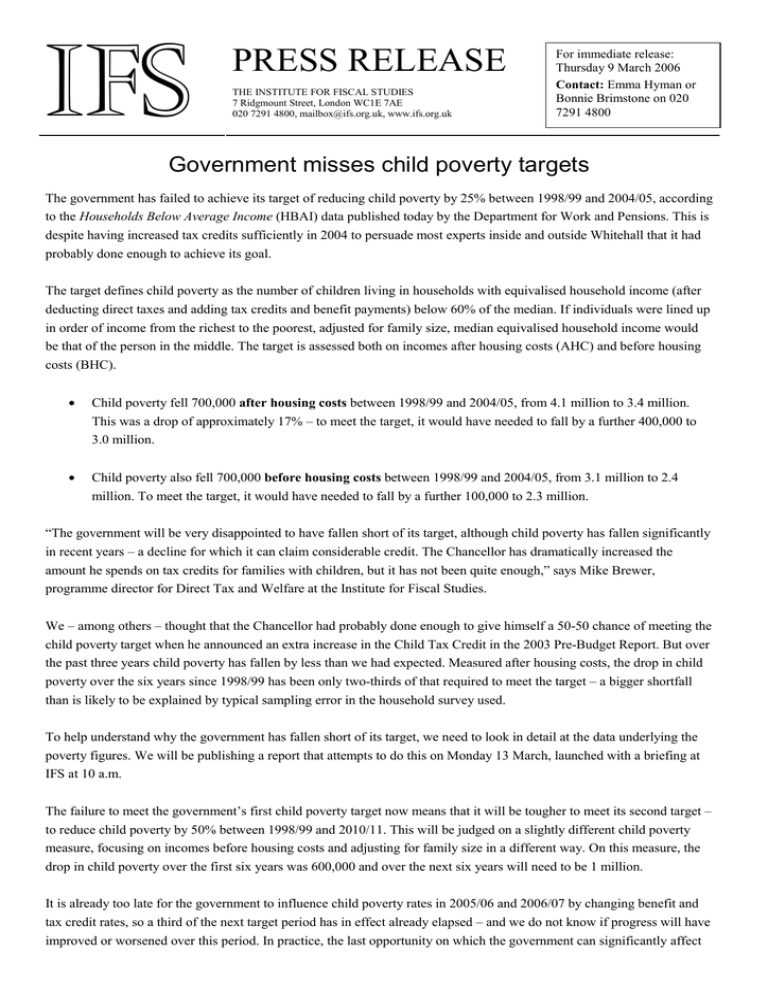IFS PRESS RELEASE
advertisement

IFS PRESS RELEASE THE INSTITUTE FOR FISCAL STUDIES 7 Ridgmount Street, London WC1E 7AE 020 7291 4800, mailbox@ifs.org.uk, www.ifs.org.uk For immediate release: Thursday 9 March 2006 Contact: Emma Hyman or Bonnie Brimstone on 020 7291 4800 Government misses child poverty targets The government has failed to achieve its target of reducing child poverty by 25% between 1998/99 and 2004/05, according to the Households Below Average Income (HBAI) data published today by the Department for Work and Pensions. This is despite having increased tax credits sufficiently in 2004 to persuade most experts inside and outside Whitehall that it had probably done enough to achieve its goal. The target defines child poverty as the number of children living in households with equivalised household income (after deducting direct taxes and adding tax credits and benefit payments) below 60% of the median. If individuals were lined up in order of income from the richest to the poorest, adjusted for family size, median equivalised household income would be that of the person in the middle. The target is assessed both on incomes after housing costs (AHC) and before housing costs (BHC). • Child poverty fell 700,000 after housing costs between 1998/99 and 2004/05, from 4.1 million to 3.4 million. This was a drop of approximately 17% – to meet the target, it would have needed to fall by a further 400,000 to 3.0 million. • Child poverty also fell 700,000 before housing costs between 1998/99 and 2004/05, from 3.1 million to 2.4 million. To meet the target, it would have needed to fall by a further 100,000 to 2.3 million. “The government will be very disappointed to have fallen short of its target, although child poverty has fallen significantly in recent years – a decline for which it can claim considerable credit. The Chancellor has dramatically increased the amount he spends on tax credits for families with children, but it has not been quite enough,” says Mike Brewer, programme director for Direct Tax and Welfare at the Institute for Fiscal Studies. We – among others – thought that the Chancellor had probably done enough to give himself a 50-50 chance of meeting the child poverty target when he announced an extra increase in the Child Tax Credit in the 2003 Pre-Budget Report. But over the past three years child poverty has fallen by less than we had expected. Measured after housing costs, the drop in child poverty over the six years since 1998/99 has been only two-thirds of that required to meet the target – a bigger shortfall than is likely to be explained by typical sampling error in the household survey used. To help understand why the government has fallen short of its target, we need to look in detail at the data underlying the poverty figures. We will be publishing a report that attempts to do this on Monday 13 March, launched with a briefing at IFS at 10 a.m. The failure to meet the government’s first child poverty target now means that it will be tougher to meet its second target – to reduce child poverty by 50% between 1998/99 and 2010/11. This will be judged on a slightly different child poverty measure, focusing on incomes before housing costs and adjusting for family size in a different way. On this measure, the drop in child poverty over the first six years was 600,000 and over the next six years will need to be 1 million. It is already too late for the government to influence child poverty rates in 2005/06 and 2006/07 by changing benefit and tax credit rates, so a third of the next target period has in effect already elapsed – and we do not know if progress will have improved or worsened over this period. In practice, the last opportunity on which the government can significantly affect its chances of hitting the target will be the Pre-Budget Report of 2009, in which it will set benefit and tax credit rates for 2010/11. “This year’s disappointing figures have left the government a bigger mountain to climb to meet its next target – child poverty will have to fall half as quickly again over the next six years as it has done over the past six years. But it is now becoming harder to target money on families with children without weakening work incentives. And the Chancellor has signalled a squeeze on public spending growth over the next few years, which means that there is likely to be less money available to channel into tax credits,” says Jonathan Shaw, research economist at IFS. Other figures released today show: • Average household incomes grew relatively slowly in 2004/05, posting increases of approximately 1% on both the mean and median. These are probably not statistically significantly different from zero. Growth in living standards has been noticeably weaker over the last couple of years than previously under Labour. • Between 1996/97 and 2000/01, income inequality rose to its highest level since comparable records began in 1961 as measured by the Gini coefficient. Since then, income inequality has fallen back to roughly the level Labour inherited. • Pensioner poverty has again fallen sharply. There are now 1.8 million pensioners in relative poverty AHC and 2.0 million in poverty BHC, a fall in poverty rates since 1996/97 of over a third AHC and 18% BHC. The poverty rate amongst pensioners (AHC) remains lower than amongst the rest of the population. • With the government focusing resources on families with children and pensioners, poverty amongst the workingaged non-parent population has received less attention. Poverty in this group is now about one percentage point higher than it was in 1998/99, on both BHC and AHC measures. • Looking at the population as a whole, there are now 11.4 million individuals in poverty AHC and 9.2 million BHC. The proportion in poverty AHC has fallen roughly from a quarter in 1996/97 to a fifth in 2004/05. Although poverty is below its 1996/97 peak, it remains considerably higher than before its steep rise during the 1980s. For example, the AHC poverty rate was about a third lower on average in the 1960s and 1970s than it is today. Poverty lines (60% of median household equivalised income) in 2004/05 include: £ per week Childless couple Single individual £100 Couple, one child (age 8) £225 Couple, two children (ages 1 & 3) £228 £183 £210 £128 £258 £266 Lone parent, Lone parent, one child two children (ages 1 & 3) (age 8) £142 £146 AHC BHC £176 £184 Relative child poverty measured after housing costs (AHC): number of children living in households with income below 60% of median income 4.4 4.2 4.0 3.8 3.6 3.4 3.2 3.0 2.8 1996 1997 1998 1999 2000 Child Poverty 2001 2002 2003 2004 Target Path Note: Years are financial years (e.g. 1996 refers to financial year 1996/97). Relative child poverty measured before housing costs (BHC): number of children living in households with income below 60% of median income 3.4 3.2 3.0 2.8 2.6 2.4 2.2 2.0 1996 1997 1998 1999 2000 Child Poverty 2001 2002 2003 2004 Target Path Note: Years are financial years (e.g. 1996 refers to financial year 1996/97). ENDS Notes to editors: 1. Households Below Average Income can be found on the Department for Work and Pensions website at www.dwp.gov.uk/asd/hbai/hbai2005/contents.asp. 2. Further analysis of the data underlying the official statistics will available in Poverty and Inequality in Britain: 2006 by Mike Brewer, Alissa Goodman, Jonathan Shaw and Luke Sibieta. 3. This report will be launched at IFS on Monday 13th March 2006. The briefing will start at 10am and is expected to conclude by 11.30am. If you would like to attend, please contact Bonnie Brimstone (020 7291 4800 or bonnie_b@ifs.org.uk).






